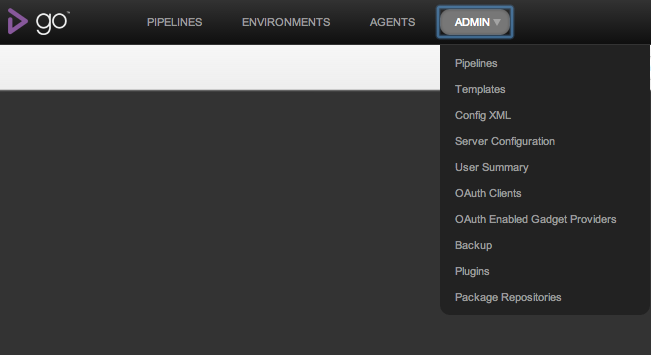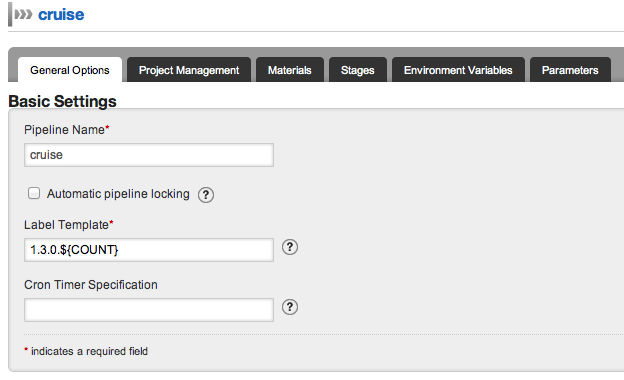- Home
- Download as PDF
- Contribute
- Introduction
- 1. Concepts In Go
- 2. Go Tour
- 3. Installing Go
-
4.
Configuration
- 4.1. Setup a New Pipeline
- 4.2. Managing Pipelines
- 4.3. Managing Dependencies
- 4.4. Managing Agents
- 4.5. Managing Environments
- 4.6. Pipeline Labelling
- 4.7. Pipeline Scheduling
- 4.8. Parameterize a Pipeline
- 4.9. Customize a Pipeline Label
- 4.10. Clone a Pipeline
- 4.11. Lock a Pipeline
- 4.12. Add Material to Existing Pipeline
- 4.13. Add Stage to Existing Pipeline
- 4.14. Add job to Existing Stage
- 4.15. Add task to Existing Job
- 4.16. Pipeline Templates
- 4.17. Choose When a Stage Runs
- 4.18. Timer Trigger
- 4.19. Job Timeout
- 4.20. Managing Users
- 4.21. Authentication
- 4.22. Authorizing Users
- 4.23. Delegating Group Administration
- 4.24. Pipeline Group Administration
- 4.25. Publish Reports and Artifacts
- 4.26. Managing Artifacts and Reports
- 4.27. Auto Delete Artifacts
- 4.28. UI Testing
- 4.29. Mailhost Information
- 4.30. Notifications
- 4.31. TFS Material configuration
- 4.32. Reference
- 4.33. Schema
-
5.
Advanced Usage
- 5.1. Auto Register a Remote Agent
- 5.2. Spawn multiple instances of a Job
- 5.3. Multiple Agents on One Machine
- 5.4. Clean on Task Cancel
- 5.5. Conditional Task Execution
- 5.6. Trigger With Options
- 5.7. Fan In
- 5.8. Properties
- 5.9. Compare Builds
- 5.10. Graphs
- 5.11. Command Repository
- 5.12. Backup Go Server
- 5.13. Other Config Options
- 6. Integrating Go With Other Tools
- 7. Go Api
- 8. Extension Points Of Go
-
9.
FAQ/Troubleshooting
- 9.1. Ordering of Pipelines
- 9.2. Historical Configuration
- 9.3. Concurrent Modifications to Config
- 9.4. Why the Build is Broken?
- 9.5. See artifacts as sub-tabs
- 9.6. Save Properties for a Build
- 9.7. Using Environment variables
- 9.8. Deploy to an environment
- 9.9. See changes in new binary
- 9.10. Run Tests against new Builds
- 9.11. Check What's Deployed
- 9.12. Deploy a Specific Build
- 9.13. Clone/Copy an Existing Agents
- 9.14. OAuth Overview
- 9.15. What is OAuth?
- 9.16. What is OpenSocial?
- 9.17. How do I re-run jobs?
- 9.18. Go unable to poll for changes
- 9.19. Artifact integrity verification
- 9.20. Email Notifications
- 9.21. Running out of Disk Space
- 10. Beta features
- 11. Release History
- Published using GitBook
Use a custom pipeline label
When using Go to build your application, it is often useful to be able to include extra information in the label Go uses. For example, you might want to have your label contain a static major.minor version number in addition to the unique count of the pipeline.
- Click on the Administration tab

- Edit the pipeline

- Add the label template

- Click save
Using material revisions
You might also want to include material revision into the pipeline label so that it's easier to find a Go pipeline by material revision and vice versa. For example, you might have a pipeline with a svn material. The following example shows how to include svn material revision into pipeline label:
<pipeline name="main" labeltemplate="1.3.${COUNT}-${svn}">
<materials>
<svn url="http://server/path" materialName="svn" />
<materials>
...
</pipeline>
Using truncated material revisions
You can optionally truncate a material revision. This can be useful when using Git materials as they have long revision numbers. By adding a "[:7]" you can have a short, truncated version of the Git revision hash that has exactly 7 characters. (Please note a subtle difference between this truncated Git revision and the "official Git short revision". The later one might be 4-7 characters long as Git tries to find a unique hash that's as short as possible. See the documentation of git-rev-parse under "--short" for further details.)
<pipeline name="main" labeltemplate="15.1.${COUNT}-${git[:7]}">
<materials>
<git url="git://github.com/foo.git" materialName="git" />
<materials>
...
</pipeline>
Using upstream pipeline labels
You can also include the revision of an upstream pipeline into the pipeline label to, for example, share the same revision across different but related pipelines:
<pipeline name="upstream" labeltemplate="1.3.${COUNT}-${svn}">
<materials>
<svn url="http://server/path" materialName="svn" />
<materials>
...
</pipeline>
<pipeline name="downstream" labeltemplate="${upstream}">
<materials>
<pipeline pipelineName="upstream" stageName="dev" materialName="upstream" />
<materials>
...
</pipeline>
In this case, if the label of upstream pipeline is "1.3.0-1234", then when downstream pipeline is triggered, the label of downstream pipeline is also "1.3.0-1234".
Using parameters
You can also include parameters into the pipeline label:
<pipeline name="main" labeltemplate="15.1.${COUNT}-#{param1}">
<params>
<param name="param1">default</param>
</params>
...
</pipeline>